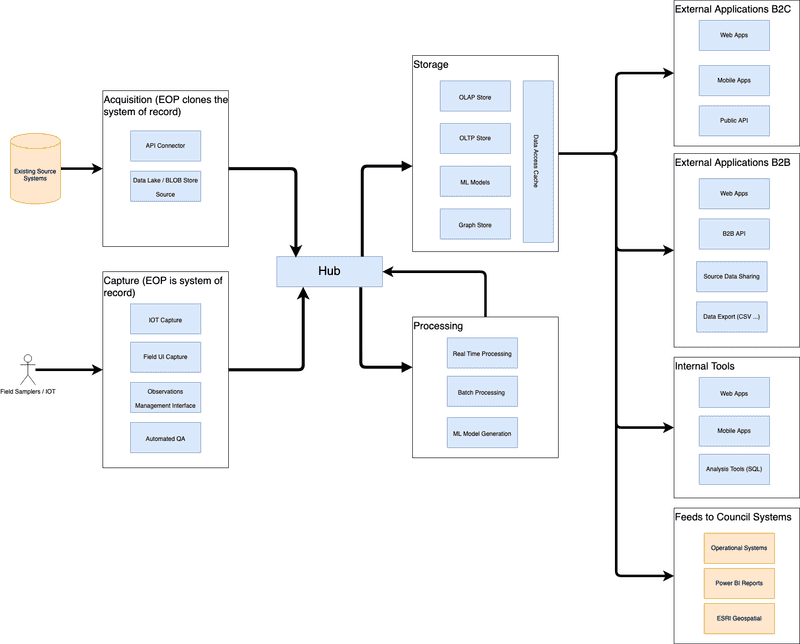Technical Design
This design is still subject to change as EOP evolves. In particular, it has been developed without the scope intended by the proposed Environmental Data Management System (EDMS) solution being clear. That may impact the scope of what EOP does
Principals
These are the principles that drive the design and development of EOP.
-
Leverage existing data - Enable councils to reuse existing data and integrate this in ways that produce outcomes that are currently difficult.
-
Design and delivery iteratively - Plan for the future, but start small and iterate, ensuring value and outcomes are delivered early.
-
Support real-time and batch - Design to support real-time and batch processing. Use the data and outcomes to drive which is required, rather than technical choices and constraints.
-
Plan for scale - Anticipate and design for the scale required to support the needs of multiple councils.
-
Designed for integration - Enable EOP to integrate well with other system including systems of record and services that EOP can add value to.
Structure
EOP is being developed as a hub and spoke model. Data is captured or acquired from external sources and sent to a central hub in a raw format. This can then be consumed for processing and storage by multiple components depending on needs.
As an example, the same data captured in the Hub might be subsequently stored in a data warehouse for analysis, and also processed in realtime for operational alerting.
Kafka has been chosen as a scalable, loosely-coupled Hub, with well supported connectors to other systems. Kafka is often used for real time processing, and is also well suited to consuming data that from batch processes.
The following diagram shows the high-level relationship between the different classes of components that will be delivered around the hub
Acquisition
Acquisition components support ingestion of data from existing systems into EOP. These might be existing council systems or third party systems housing data which EOP can make use of. Acquisition will be the the initial focus for EOP.
The preference is for councils to push data to EOP, rather than for EOP to pull. This allows councils to control the frequency of updates. However, there will be some cases where pulling data from a system is required, such as data from third party systems that can't be changed.
There will be special cases for tools that are ubiquitous across the councils that EOP can pull from standard interfaces without per council integration. For example, ESRI and Hilltop.
Example Acquisition components:
- JSON API's exposed to councils
- Data lake / Blob storage style end points for bulk data
- Pulling from Hilltop / ESRI API's
- Direct connection from Kafka Connectors running in council environments
Capture
Capture components support ingestion of data where EOP is the system of record. These will be developed when there is an opportunity to improve on existing data capture tools for all councils, such as supporting newer data-standards or capturing meta-data not-supported by existing systems.
This type of component is a longer term goal for the EOP.
Example Capture components:
- Field capture user interface that may be running on a mobile device
- IOT endpoints for capturing data from sensors
- User interfaces for QA review
Data Stores
Multiple data store components may be used to allow modelling and querying based on the type analysis required.
Using a Hub and Spoke model allows the EOP to remain agnostic of the data store solutions used now and in the future.
Example Data store components:
- OLTP database for fast operational access
- OLAP database for slower analytical access
- Graph database for network analysis
Processing
Processing components perform analysis on the data stored in EOP.
These are decoupled from the data stores, and designed to be a key extension point for adding new analysis capability without affecting other components.
Example Processing components:
- Real time processing, driven from kafka streams
- Batch processing, driven from data in OLAP data stores
- Data science scripts (R / Python) for analysis e.g. Naturalised flow
- AI model training
Output
Output components present information captured and generated by EOP to various types of users, with a focus on outcomes.
The diagram shows these grouped by the type of user emphasise a user-centric, rather than technology-centric approach. E.g. multiple web applications or APIs may be developed to serve difference audiences.
Example Processing components:
- UI Viewers
- API endpoints
- Bulk data downloads
External Applications B2C
Applications intended for public use. These should be focussed on presenting information and outcomes in a user-friendly way.
External Applications B2B
Applications intended for use by third-party organisations including central government. This could be information for particular types of reporting, often provided as exports for use in third party systems.
Internal Tools
Tools used by council staff to perform day-to-day work. These might task-focussed applications, developed for users with particular expertise in the data.
Feeds to Council Systems
These may be useful where EOP has created information that is valuable for presentation by existing council systems.
